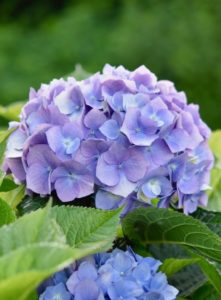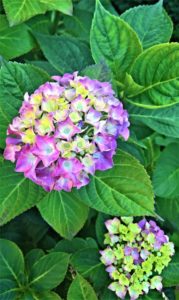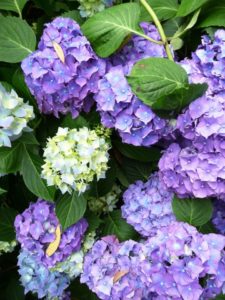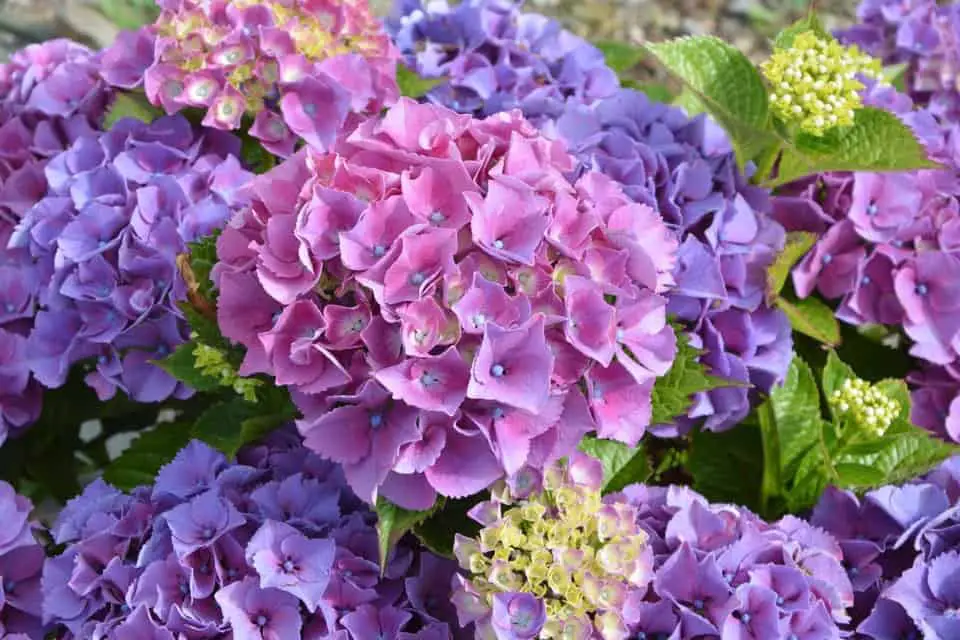Some links in the post are affiliate links and I get a commission from purchases made through some links found in the post.
Any avid gardener will agree that hydrangeas are among the most versatile plants in the garden.
They bloom continuously through summer and right into fall, and can be grown in several different colours. You may see them in whites, blues, pinks and even reds.
Hydrangeas prefer partial shade areas if they are to do well. Planting them around your house will add beauty to the appearance as well as privacy if you choose to use them as hedges.
If you have any dull areas in your garden, you may want to plan on growing them there to brighten up the area.
Landscaping with Hydrangeas
Because they need more water than many other shrubs in the garden you should also consider putting some type of irrigation in place. While they do not like soggy soil, they do need good drainage and moist soil around them.
One of the advantages of landscaping with hydrangeas is that they come in all sizes so you should always be able to find one that will suit the place you want it to grow.
Because of the thick foliage hydrangeas can successfully be used as hedges, thus ensuring you extra privacy. If you have a seating area which is open to the public, consider growing hydrangeas there.
Some hydrangeas grow as small as 3’ tall while others can reach between 25’ high and 12’ wide – quite the monster plant!
A Little About Hydrangeas

Most hydrangeas prefer partial shade although there are some that will do well in full sun. This largely depends on your own location.
Planting in northern temperatures will mean plants can adapt to full sun while the warmer southern climates will need only a few hours of early morning sun.
Some hydrangeas bloom in the early season but generally they bloom in summer and into early fall.
Occasionally your hydrangea will bloom in one colour and then as the plant ages, change to another shade. The most common colours are pinks, purple, blue and whites, with red less usual.
Colours can be manipulated depending on the type of soil and the pH that you change it to.
An important note: Both the leaves and the flower buds are harmful to dogs and cats and will make them seriously ill if digested.
The best time to plant hydrangeas is in the spring or the fall, when there is no threat of frost.
What is the Best Location to Plant a Hydrangea?
Finding the best spot to plant your hydrangea is important if you want your plant to thrive and beautify your garden.
A point to remember is that hydrangeas love the early morning sun and do not enjoy the hot afternoon sun very much.
Look for a sheltered location which catches the sunrise and then has shady afternoons. This may be up against one side of your house rather than in an area where the plants are exposed to the sun all day.
Another point to remember is to avoid planting hydrangeas under other trees. This is because the trees compete for nutrients in the soil, with the hydrangea almost always losing out on this.
High winds can easily damage hydrangeas so better to place them against a wall than in the centre of the lawn.
Are Hydrangeas Good for the Front of the House?
Hydrangeas used in landscaping at the front of houses have always been a popular idea. With their large blooms they can perk up any dull appearance at the front of the house.
They do well in borders and around front porches where they are also sheltered from high winds.
Once established they are relatively low maintenance plants considering the number of blooms they produce.
A mistake that is often made when planting hydrangeas around the front of the house is not choosing the right plant. Some will grow to enormous heights and can completely cut out light to any front windows.
Additionally, some of them spread to about 12’ so you need to be sure that when mature the plant does not overpower your house and every other plant near it.
For help with landscaping at home, check out this article here which could help you save $000’s on landscaping fees.
Landscaping with Hydrangeas and Hostas
Hostas, like hydrangeas, can come in several different colours and sizes. They range from about 6” across to up to 6’ wide.
As with hydrangeas hostas enjoy the morning sun and not the heat of the afternoon. In fact, hostas can do well in more shade than hydrangeas which makes the smaller plants ideal for planting as a ground cover around hydrangeas.
Larger hostas will shade out any weeds with their big leaves so help to keep the area weed free.
This combination of plants will give a good privacy hedge as they can both reach about 6’ tall and become very bushy.
Before you buy either plant you should decide where you want to plant them and where they will be seen from as the hydrangea will eventually grow higher than the hosta.
You can use the same mulch under both plants.
Landscaping with Hydrangeas and Boxwoods
This is one of those unique combinations that just look so good, you wonder why you don’t see them in every garden! Together hydrangea and a neat boxwood hedge in front simply spells class and style.
The one compliments the other in that hydrangeas appear soft and fresh while the boxwood is formal and can support the hydrangeas without being intrusive.
Even when hydrangeas stems become a little leggy and weighted down by the large blooms, the boxwood will support it and keep things in order.
Boxwood grows slowly and this makes it easy to shape if you so desire. They are also cold-resistant and drought-resistant.
Boxwood will be happy wherever you plant your hydrangeas, they tolerate shade, semi shade and even sunlight and still look good all year round.
When you fertilize your hydrangea, the boxwood will appreciate a dose as well.
Landscaping with Hydrangeas and Grasses
 This is another great combination of plants. You may not have considered them before, but the effect is simply stunning and well worth trying.
This is another great combination of plants. You may not have considered them before, but the effect is simply stunning and well worth trying.
Both hydrangeas and grasses will make a great privacy screen with many grasses coming in delightful shades to keep your garden colourful all year.
Most grasses are drought and heat tolerant and require very little attention. Even better, they are not unduly bothered by pests and diseases. In fact, most grasses are tough and versatile.
One thing that needs to be remembered with grasses is that they need to be cut back to close to the ground in early spring so if they are being used as a privacy hedge you should plant hydrangeas behind them so that the screen is maintained.
Grasses can easily adapt to full, and partial shade, as well as to full sun, so wherever your hydrangea is happiest, the grasses will fit right in.
Once your grasses are established they will only need watering twice a week so you may need to water your hydrangeas more frequently than the grasses.
Landscaping with Hydrangeas and Azaleas
Azaleas planted with hydrangeas make an excellent combination because azaleas tend to start blooming earlier than hydrangeas. They also end earlier.
So, you’ll get the azaleas blooming early in the season and then the hydrangeas coming into their own a little later to give a full display of colour through the summer and into early fall – an absolute delight for any garden!
Like hydrangeas, azaleas prefer partial sun conditions and the morning sun rather than the afternoon heat.
In the hottest and driest conditions azaleas, like hydrangeas will need watering at least twice a week. They cannot survive in drought conditions.
This means that when you water your hydrangeas you simply water your azaleas as well. Very convenient.
As with hydrangeas the soil needs to drain well because neither plant enjoys sodden roots.
Landscaping with Hydrangeas and Roses
Roses and hydrangeas make a wonderful combination, particularly as roses come in so many different colours and will simply compliment your hydrangeas all year round.
Both roses and hydrangeas need well-drained soil, and both will bloom in summer to early fall. Neither does well with soggy soil.
Roses can tolerate full sun in the temperatures are not extremely high. Planting them in semi shade will be far more pleasant for them.
What is appealing about this combination is the difference in the foliage which gives a striking contrast, one with large green leaves and the other with far smaller and varying green shades of leaves.
Both will appreciate fertilizer once during the growing season.
Landscaping with Peonies and Hydrangeas
Now this is a combination which may not be the ‘match made in heaven’ as other combinations are. That being said, in the right climate this combination can work very well.
Hydrangeas do not need too much sun. In fact, they prefer less, needing just and average of 6 hours of early morning sun. Actually, they do well on less than this.
They can however, cope with up to 8 hours in colder climates, but generally they do not like afternoon sun.
Peonies on the other hand need at least 7 hours of direct sunlight to do well. In fact, they would prefer to be planted in the open where they can bask in 10-12 hours of direct sunlight each day.
If you provide this for them you will be rewarded with lush foliage and abundant blooms.
If peonies do not have a decent amount of direct sunlight they may simply not ever bloom.
The only exception – and this is where the combination can work – is in hot conditions where they would benefit from some shade in the heat of the afternoons.
While hydrangeas can normally support themselves because their stems are woody and strong, peonies can be almost blown down in high winds or rain.
The stems need to be staked well to keep them upright otherwise they lose their attraction.
Hydrangeas can easily support themselves even in a heavy rain and they will very seldom be damaged by the elements.
Another thing to remember when combining the two is that peonies die off at the end of the season and sprout again in the spring, whereas the hydrangeas does not die off in the winter.
Hydrangeas produce several blooms on each stem while peonies only produce one flower per stem.
Can you use Hydrangeas in Pots to Landscape?
Yes, you most certainly can. In fact, having your favourite plants in pots means that you can easily move it to another place where it may be happier.
You can also arrange other potted plants around it and swap them around as they stop blooming.
If you plan to use pots then there are some things you may think about.
- Rather than using soil from your garden, choose a good quality potting mix. This will come with nutrients in it whereas garden soil may not contain many.
- Add a slow-release fertilizer. This will give any potted plants a head start.
- Make sure that there is between 1-2” of space between the soil and the top of the pot so that you can give your hydrangea a good soaking.
- Never use a pot that does not have drainage holes.
- Use a decent sized pot to give your plant enough space to grow.
We have an article on the common problems with hydrangeas in pots.
Final Thoughts
 An interesting fact about hydrangeas is that if you want to change the colours of the blooms from white and pink to blue you simply need to change the pH of the soil they are planted in.
An interesting fact about hydrangeas is that if you want to change the colours of the blooms from white and pink to blue you simply need to change the pH of the soil they are planted in.
For blue flowers the soil pH needs to be 5.5 and lower, while for pink colours the pH should be 6.5 and above.
While there are several theories about changing the soil pH (I’m sure you have heard about adding old nails around the plant) it is just as quick and easy to add a fertilizer such as Azalea, Camellia, and Gardenia Planting Mix. This will give you a ‘true blue’ hydrangea.
Hydrangeas make amazing additions to any garden when planted in the right spot. They make an even more stunning feature when combined with other plants.
With a little forethought of how large your plant will be at maturity, and care about where you place it, there is no reason why you should not add these delightful plants to your garden.
Before you go, here are some more related articles I encourage you to read below to help solve more of your gardening issues:
How do you get Rid of Black Spots on Hydrangea Leaves
Why Are My Hydrangea Leaves Curling


